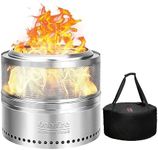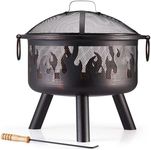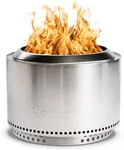Buying Guide for the Best Portable Fire Pits
Choosing the right portable fire pit can enhance your outdoor experience, whether you're camping, hosting a backyard gathering, or simply enjoying a cozy evening under the stars. When selecting a portable fire pit, consider factors such as size, material, fuel type, and ease of use. These elements will determine how well the fire pit suits your needs and how convenient it is to transport and maintain. Understanding the key specifications will help you make an informed decision that aligns with your lifestyle and intended use.SizeThe size of a portable fire pit is crucial because it affects both the portability and the amount of heat it can produce. Smaller fire pits are easier to transport and store, making them ideal for camping trips or small patios. Medium-sized fire pits offer a balance between portability and heat output, suitable for moderate gatherings. Larger fire pits provide more heat and can accommodate bigger groups, but they are less portable. Consider how many people you typically entertain and how much space you have available when choosing the size.
MaterialThe material of a fire pit impacts its durability, weight, and heat retention. Common materials include stainless steel, cast iron, and aluminum. Stainless steel is lightweight and resistant to rust, making it a good choice for frequent movers. Cast iron is heavier but offers excellent heat retention and durability, ideal for stationary use. Aluminum is lightweight and rust-resistant but may not retain heat as well as other materials. Choose a material based on how often you plan to move the fire pit and the climate conditions it will face.
Fuel TypePortable fire pits can use different types of fuel, such as wood, propane, or gel. Wood-burning fire pits provide a traditional experience with crackling sounds and a smoky aroma, but require more effort to start and maintain. Propane fire pits offer convenience with easy ignition and adjustable flames, making them suitable for quick setups and urban areas. Gel fuel pits are clean-burning and easy to use, but may not produce as much heat. Consider your preference for ambiance, ease of use, and environmental impact when selecting a fuel type.
Ease of UseEase of use encompasses how simple it is to set up, ignite, and clean the fire pit. Some fire pits come with features like automatic ignition systems, adjustable flame controls, and easy-clean designs. If you prefer a hassle-free experience, look for models with these features. Consider how often you plan to use the fire pit and how much time you're willing to spend on maintenance. A user-friendly design can enhance your enjoyment and encourage more frequent use.
PortabilityPortability is a key factor for those who plan to move their fire pit frequently. Look for features like lightweight construction, carrying handles, or collapsible designs that make transportation easier. If you intend to use the fire pit in various locations, such as camping sites or different areas of your backyard, prioritize portability. Consider how often you'll be moving the fire pit and the distance you'll be carrying it to ensure it fits your mobility needs.
















